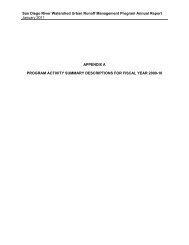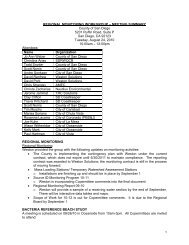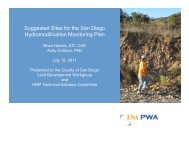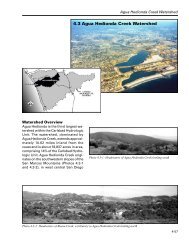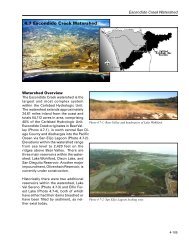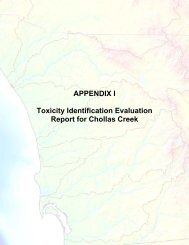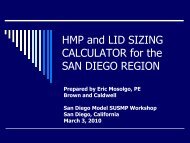APPENDIX I Toxicity Identification Evaluation Reports for Chollas ...
APPENDIX I Toxicity Identification Evaluation Reports for Chollas ...
APPENDIX I Toxicity Identification Evaluation Reports for Chollas ...
You also want an ePaper? Increase the reach of your titles
YUMPU automatically turns print PDFs into web optimized ePapers that Google loves.
<strong>Toxicity</strong> <strong>Identification</strong> <strong>Evaluation</strong> of <strong>Chollas</strong> Creek<br />
Stormwater using Hyalella azteca<br />
Results<br />
August 2006<br />
the enzymatic degradation of the chemicals in the sample, and provide more evidence that the<br />
causative agents of toxicity are pyrethroids.<br />
A copper sulfate reference toxicant was tested at nominal concentrations of 62.5, 125, 250, 500<br />
and 1000 µg Cu 2+ /L. The calculated 96-hour LC 50 (159.20 µg Cu 2+ /L) was within two standard<br />
deviations of the laboratory mean (332.79 µg Cu 2+ /L) at the time of testing. This indicates that<br />
the sensitivity of H. azteca used in this evaluation fell within the normal range.<br />
4.1.8 Summary of TIE per<strong>for</strong>med on February 19, 2006 Sample<br />
Results from the TIE per<strong>for</strong>med on the <strong>Chollas</strong> Creek stormwater sample collected in February<br />
re-confirmed that pyrethroids were likely responsible <strong>for</strong> the observed toxicity. In accordance<br />
with the October and January TIEs, there was a lack of toxicity reduction in the EDTA, STS,<br />
graduated pH, and aeration treatments, which indicates that the causative agent was likely not a<br />
metal, an oxidative chemical, a pH-sensitive chemical, nor a volatile chemical or surfactant,<br />
respectively. However, the reduction in toxicity of H. azteca following filtration of the stormwater<br />
sample indicates that the causative agent was highly bound to particulates in the sample.<br />
These results support the evidence provided by the October and January TIEs which indicate<br />
that the causative agents have similar physicochemical properties to those of pyrethroids. Also<br />
similar to results of the tests per<strong>for</strong>med in October, November, and January, PBO treatments<br />
led to increased toxicity in the undiluted stormwater sample. The repeated potentiation of<br />
toxicity using PBO in all recent TIEs provides strong evidence that pyrethroids are the causative<br />
agents, because pyrethroid toxicity is well-known to increase following the addition of PBO<br />
(Budavari, 1989). The carboxyl esterase treatment caused a reduction in toxicity in the undiluted<br />
stormwater sample, whereas toxicity was not removed in the BSA treatment, used as a control<br />
<strong>for</strong> the carboxyl esterase. These results indicate that the chemical(s) causing toxicity in the<br />
stormwater sample was enzymatically degraded by carboxyl esterase, and not just adsorbed to<br />
binding sites on these proteins (BSA and esterase), and support the idea that pyrethroids were<br />
the causative agent in the <strong>Chollas</strong> Creek stormwater sample. Finally, results of the combined<br />
carboxyl esterase and PBO test demonstrate toxicity similar to the level of that in the<br />
unmanipulated Baseline test. Because In contrast, PBO alone increased toxicity while carboxyl<br />
esterase alone reduced toxicity, the lack of significant change in toxicity measured in the<br />
combined carboxyl esterase plus PBO test indicates that the synergistic effects of PBO together<br />
with chemicals in the sample are cancelled out by the enzymatic degradation of the chemicals in<br />
the sample, and re-confirm that the causative agents of toxicity are likely pyrethroids.<br />
4.2 CHEMICAL ANALYSES OF CHOLLAS CREEK STORMWATER<br />
Below is a summary of chemical analyses per<strong>for</strong>med on <strong>Chollas</strong> Creek stormwater samples<br />
during the 2005-2006 monitoring season (Table 7). Briefly, with the exception of malathion, all<br />
organophosphate pesticides were below the detection limit. Malathion was found at<br />
concentrations ranging from 89 to 345 ng/L across all storm events, all of which were below the<br />
water quality objective of 430 ng/L. All dissolved metals analyzed were found at concentrations<br />
in the <strong>Chollas</strong> Creek water sample that were below their water quality objectives, with the<br />
exception of dissolved copper, which only exceeded its water quality objective in the February<br />
stormwater sample. Concentrations of total cadmium, chromium, nickel, and silver were below<br />
their respective water quality objectives. Concentrations of total copper, lead, and zinc in the<br />
October, January, and February samples exceeded their water quality objectives. Initial<br />
analyses of pyrethroids and PBO a chemical used as a pyrethroid synergist in pesticide<br />
<strong>for</strong>mulations, were not detected in either the October, or the January stormwater samples.<br />
These samples were initially analyzed using the gas chromatography – mass spectrometry (GC-<br />
Weston Solutions, Inc. 24







